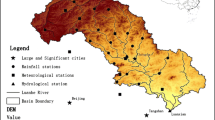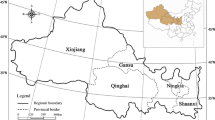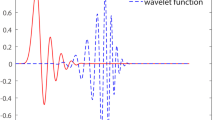Abstract
Univariate drought indicators are insufficient for characterizing the complicated effects and conditions of droughts. Accordingly, this study aimed to introduce and assess a composite drought index called the Integrated Drought Index (IDI), composed of the most important water balance variables including, temperature, precipitation, streamflow, and soil moisture to simultaneously monitor hydrological, agricultural, and meteorological drought. To this end, four widely used linear and non-linear combination approaches—namely the kernel mean component analysis (KMCA), copula function (CF), entropy weighting (EW), and the principal component analysis (PCA)—were used here, whose products are called IDI-KMCA, IDI-CF, IDI-EW, and IDI-PCA, respectively. The research data were extracted from ERA5 (ECMWF Reanalysis v5) datasets on a monthly scale for the 1979–2020 period. According to the findings, all proposed composite indices exhibited a mostly similar variation pattern as the individual indices and performed well in monitoring drought conditions—except for IDI-CF, which slightly deviated from the pattern during the 1989–1990 period. High values of the index of agreement (with the average values ranging between 0.5 and 0.9) and correlation coefficient (with the average values ranging between 0.7 and 0.9) also suggested a good agreement among the proposed composite indices. Since climate and hydrologic conditions in the region were not complex, they evaluated the same drought conditions through linear and non-linear approaches. In addition, Frank functions were selected to derive the joint distribution functions of drought characteristics for bi-variate and tri-variate functions. Finally, considering the spatial distribution of the drought return period, the probability of mild droughts remained the same under bi-variate and tri-variate conditions, whereas the occurrence probability of extreme drought changed (increasing and decreasing in the case of "and" and "or").












Similar content being viewed by others
Availability of Data and Materials
Available on request.
Notes
European Centre for Medium-Range Weather Forecasts.
ECMWF Reanalysis Interim.
Inference Function for Margins.
References
AghaKouchak, A. (2014). A baseline probabilistic drought forecasting framework using standardized soil moisture index: application to the 2012 United States drought. Hydrol Earth Syst Sci 18(7):2485–2492
AghaKouchak A, Farahmand A, Melton FS, Teixeira J, Anderson MC, Wardlow BD, Hain CR (2015) Remote sensing of drought: Progress, challenges and opportunities. Rev Geophys 53(2):452–480. https://doi.org/10.1002/2014RG000456
Ahmad MI, Sinclair CD, Werritty A (1988) Log-logistic flood frequency analysis. J Hydrol 98(3–4):205–224. https://doi.org/10.1016/0022-1694(88)90015-7
Amin MT, Mahmoud SH, Alazba AA (2016) Observations, projections and impacts of climate change on water resources in Arabian Peninsula: current and future scenarios. Environ Earth Sci 75(10):864. https://doi.org/10.1007/s12665-016-5684-4
Azhdari Z, Bazrafshan O, Zamani H, Shekari M, Singh VP (2021) Hydro-meteorological drought risk assessment using linear and nonlinear multivariate methods. Phys Chem Earth Parts a/b/c 123:103046
Beersma JJ, Buishand TA (2004) Joint probability of precipitation and discharge deficits in the Netherlands. Water Resour Res 40(12)
Dionisio, A., Menezes, R., & Mendes, D. A. (2007). Entropy and uncertainty analysis in financial markets. arXiv preprint arXiv:0709.0668.
Ebrahimi N, Maasoumi E, Soofi ES (1999) Ordering univariate distributions by entropy and variance. J Econom 90(2):317–336
Fahimirad Z, Shahkarami N (2021) The impact of climate change on hydro-meteorological droughts using copula functions. Water Resour Manag 35(12):3969–3993. https://doi.org/10.1007/s11269-021-02918-z
FAO (2017) Drought characteristics and management in Central Asia and Turkey. Rome
Hameed M, Ahmadalipour A, Moradkhani H (2020) Drought and food security in the middle east: An analytical framework. Agric Meteorol 281:107816. https://doi.org/10.1016/j.agrformet.2019.107816
Hao Z, AghaKouchak A (2013) Multivariate standardized drought index: a parametric multi-index model. Adv Water Resour 57:12–18
Hao Z, AghaKouchak A, Nakhjiri N, Farahmand A (2014) Global integrated drought monitoring and prediction system. Sci Data 1(1):1–10. https://doi.org/10.1038/sdata.2014.1
Hao Z, AghaKouchak A (2014) A nonparametric multivariate multi-index drought monitoring framework. J Hydrometeorol 15(1):89–101
Hersbach H, de Rosnay P, Bell B, Schepers D, Simmons A, Soci C, Zuo H (2018) Operational global reanalysis: progress, future directions and synergies with NWP.
Jenssen R (2009) Kernel entropy component analysis. IEEE Trans Pattern Anal Mach Intell 32(5):847–860
Joe H (1997) Multivariate models and multivariate dependence concepts. CRC Press
Kao SC, Govindaraju RS (2010) A copula-based joint deficit index for droughts. J Hydrol 380(1–2):121–134
Kendall DR, Dracup JA (1992) On the generation of drought events using an alternating renewal–reward model. Stoch Hydrol Hydraul 6(1):55–68. https://doi.org/10.1007/BF01581675
Keyantash JA, Dracup JA (2004) An aggregate drought index: Assessing drought severity based on fluctuations in the hydrologic cycle and surface water storage. Water Resour Res 40(9)
Kramer MA (1991) Nonlinear principal component analysis using auto associative neural networks. AIChE J 37(2):233–243
Li Q, Li P, Li H, Yu M (2015) Drought assessment using a multivariate drought index in the Luanhe River basin of Northern China. Stoch Env Res Risk Assess 29(6):1509–1520. https://doi.org/10.1007/s00477-014-0982-4
Liu Y, Zhu Y, Ren L, Yong B, Singh VP, Yuan F, Yang X (2019) On the mechanisms of two composite methods for construction of multivariate drought indices. Sci Total Environ 647:981–991
Mahmoudi P, Ghaemi A, Rigi A, Jahanshahi SMA (2022) Retraction note to: Recommendations for modifying the standardized precipitation index (SPI) for drought monitoring in arid and semi-arid regions. Water Resour Manag 36(15):6223–6223
Mathier L, Perreault L, Bobe B, Ashkar F (1992) The use of geometric and gamma-related distributions for frequency analysis of water deficit. Stoch Hydrol Hydraul 6(4):239–254. https://doi.org/10.1007/BF01581619
McKee TB, Doesken NJ, Kleist J (1993) The relationship of drought frequency and duration to time scales. Proc Conf Appl Climatol 17(22):179–183
McKee TB, Doesken NJ, Kleist J (1995) Drought monitoring with multiple time scales. Conf Appl Climatol Am Meteor Soc 233–236
Morid S, Smakhtin V, Moghaddasi M (2006) Comparison of seven meteorological indices for drought in Iran. Int J Climatol 26:971–985
Mortuza MR, Moges E, Demissie Y, Li HY (2019) Historical and future drought in Bangladesh using copula-based bivariate regional frequency analysis. Theoret Appl Climatol 135(3):855–871
Motevali Bashi Naeini E, Akhoond-Ali AM, Radmanesh F, Koupai JA, Soltaninia S (2021) Comparison of the calculated drought return periods using tri-variate and bivariate copula functions under climate change condition. Water Resour Manag 35(14):4855–4875
Naderi K, Moghaddasi M, Shokri A (2022) Drought occurrence probability analysis using multivariate standardized drought index and copula function under climate change. Water Resour Manag 1–24
Nazeri Tahroudi M, Ramezani Y, De Michele C, Mirabbasi R (2020) A new method for joint frequency analysis of modified precipitation anomaly percentage and streamflow drought index based on the conditional density of copula functions. Water Resour Manag 34(13):4217–4231
Nelsen RB (2006) An introduction to copulas. Springer, New York. MR2197664
Nemati A, Najafabadi SHG, Joodaki G, Nadoushani S (2020) Spatiotemporal drought characterization using gravity recovery and climate experiment (GRACE) in the Central Plateau Catchment of Iran. Environ Process 7(1):135–157
Niemeyer S (2008) New drought indices. Options Méditerranéennes Série A: Séminaires Méditerranéens 80:267–274
Palmer, W. C. (1965). Meteorological drought (Vol. 30). US Department of Commerce, Weather Bureau.
Rajsekhar D, Singh VP, Mishra AK (2015) Multivariate drought index: An information theory based approach for integrated drought assessment. J Hydrol 526:164–182
Roweis ST, Saul LK (2000) Nonlinear dimensionality reduction by locally linear embedding. Science 290(5500):2323–2326
Salvadori G, De Michele C, Kottegoda NT, Rosso R (2007) Extremes in nature: an approach using copulas (Vol. 56). Springer Science & Business Media
Scanlon BR, Ruddell BL, Reed PM, Hook RI, Zheng C, Tidwell VC, Siebert S (2017) The food-energy-water nexus: Transforming science for society. Water Resour Res 53(5):3550–3556. https://doi.org/10.1002/2017WR020889
Scholkopf B, Smola A, Mller KR (1999) Kernel principal component analysis. Adv Kernel Methods-Support Vector Learn
Shiau JT (2006) Fitting drought duration and severity with two-dimensional copulas. Water Resour Manag 20(5):795–815. https://doi.org/10.1007/s11269-005-9008-9
Shukla S, Wood AW (2008) Use of a standardized runoff index for characterizing hydrologic drought. Geophys Res Lett 35(2)
Sklar M (1959) Fonctions de repartition a dimensions etleurs marges. Publ Inst Statist Univ Paris 8:229–231
Svoboda MD, LeComte D, Hayes MJ, Heim R, Gleason K, Angel J, Rippey B, Tinker R, Palecki M, Stooksbury D, Miskus D, Stevens D (2002) The drought monitor. Bull Am Meteor Soc 83:1181–1190
Thornthwaite CW (1948) An approach toward a rational classification of climate. Geogr Rev 38(1):55–94. https://doi.org/10.2307/210739
Tsakiris G, Vangelis HJEW (2005) Establishing a drought index incorporating evapotranspiration. European Water 9(10):3–11
Tsiros IX, Nastos P, Proutsos ND, Tsaousidis A (2020) Variability of the aridity index and related drought parameters in Greece using climatological data over the last century (1900–1997). Atmos Res 240:104914
Van Loon AF (2015) Hydrological drought explained. Wiley Interdiscip Rev Water 2(4):359–392. https://doi.org/10.1002/wat2.1085
Van Loon AF, Ploum SW, Parajka J, Fleig AK, Garnier E, Laaha G, Van Lanen HA (2014) Hydrological drought typology: temperature-related drought types and associated societal impacts. Hydrol Earth Syst Sci Discuss 11(9). https://doi.org/10.5194/hessd-11-10465-2014
Vergni L, Todisco FL, Mannocchi F (2015) Analysis of agricultural drought characteristics through a two-dimensional copula. Water Resour Manag 29(8):2819–2835. https://doi.org/10.1007/s11269-015-0972-4
Vicente-Serrano SM, Beguería S, Lopez-Moreno JI (2010) A Multi-scalar drought index sensitive to global warming: The Standardized Precipitation Evapotranspiration Index - SPEI. J Clim 23:1696–1718. https://doi.org/10.1175/2009JCLI2909.1
Waseem M, Ajmal M, Kim TW (2015) Development of a new composite drought index for multivariate drought assessment. J Hydrol 527:30–37. https://doi.org/10.1016/j.jhydrol.2015.04.044
Svoboda and Fuchs (2016) Handbook of drought indicators and indices, H. Geneva, Switzerland: World Meteorological Organization, 1-44.
Won J, Choi J, Lee O, Kim S (2020) Copula-based joint drought index using SPI and EDDI and its application to climate change. Sci Total Environ 744:140701
Yang J, Chang J, Wang Y, Li Y, Hu H, Chen Y, Yao J (2018) Comprehensive drought characteristics analysis based on a nonlinear multivariate drought index. J Hydrol 557:651–667
Yevjevich V, Siddiqui MM, Downer RN (1967) Application of runs to hydrologic droughts. Proceedings of International Hydrology symposium, 1(63).: 496–505
Zhu J, Zhou L, Huang S (2018) A hybrid drought index combining meteorological, hydrological, and agricultural information based on the entropy weight theory. Arab J Geosci 11(5):1–12. https://doi.org/10.1007/s12517-018-3438-1
Author information
Authors and Affiliations
Contributions
M.M.: Conceptualization, Methodology, Technical Investigation, Writing, Reviewing and Editing, Validation, Visualization, Supervision; Sh.P.: Software, Technical Investigation, Data Curation, Editing; ZS.H.: writing, original draft preparation.
Corresponding author
Ethics declarations
Ethics Approval
Not applicable, because this article does not contain any studies with human or animal subjects.
Consent to Participate
The research data were not prepared through a questionnaire.
Consent for Publication
There is no confict of interest regarding the publication of this article.
Competing Interests
The authors declare no confict of interest.
Additional information
Publisher's Note
Springer Nature remains neutral with regard to jurisdictional claims in published maps and institutional affiliations.
Rights and permissions
Springer Nature or its licensor (e.g. a society or other partner) holds exclusive rights to this article under a publishing agreement with the author(s) or other rightsholder(s); author self-archiving of the accepted manuscript version of this article is solely governed by the terms of such publishing agreement and applicable law.
About this article
Cite this article
Hosseini, Z.S., Moghaddasi, M. & Paimozd, S. Simultaneous Monitoring of Different Drought Types Using Linear and Nonlinear Combination Approaches. Water Resour Manage 37, 1125–1151 (2023). https://doi.org/10.1007/s11269-022-03418-4
Received:
Accepted:
Published:
Issue Date:
DOI: https://doi.org/10.1007/s11269-022-03418-4




